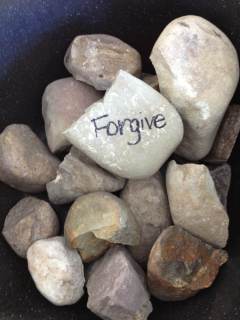“And this is eternal life, that they may
know you, the one true God, and Jesus Christ whom you have sent.” (John 17:3)
I stood looking down at the beautiful
young woman in the casket, and I thought of Shakespeare’s words when Romeo
looked at the dead Juliet:
“Death, that hath sucked the honey of thy breath,
Hath had no power yet upon thy beauty:
Thou art not conquer’d; beauty’s ensign yet
Is crimson in thy lips and in thy cheeks,
And death’s pale flag is not advanced there.”
This Juliet was a sergeant in the United
States Marine Corp. She wanted to be a Marine because she’d heard it was the
toughest branch of the military, and she wanted to be up for the challenge of
being a badass. She served two enlistments, including a tour in Iraq. She died
this past spring at the age of thirty from a drug overdose. She left behind a
young daughter and a grieving family and a lot of unanswered questions about
why so accomplished a girl couldn’t seem to pull it together following her time
in the military. The mother of Juliet’s idiot boyfriend (and there always seems
to be an idiot boyfriend who either colludes, encourages, or enables drug use.
This one couldn’t attend the funeral because he was incarcerated on drug
charges) told me she believed Juliet had suffered some trauma in the military,
but was too proud to talk about it or ask for the help she needed.
I think about Juliet this Memorial Day. I
think of my brother-in-law who died from the results of exposure to that
ungodly shit called “Agent Orange” when he was in Vietnam. It took thirty years
after his separation from the service, but that war finally killed him when he
was only fifty years old. I think of a boy I heard about this past week,
another US Marine, who died from an opioid addiction he developed while on
pre-deployment. Yes, I revere those who gave their lives in the military
service of our country, but I really mourn for the ones whose deaths weren’t in
combat—the ones who suffered lingering pain and loneliness as a result of what
they’d seen and done or had done to them. The dying doesn’t stop at the end of
the deployment or combat mission.
I hear you, Jesus. I hear your prayer for
us in the Gospel reading for Easter Seven (John 17:1-11). You’re praying that
we might be unified, because there’s safety in unity, and this is one freaky, scary,
brutal, and hostile world. And we don’t stand a snowball’s chance in it apart
from you.
I need to know and keep knowing, Lord,
that although you seem to be gone, you’re still here. You still hang out with
us. I see you in my brothers and sisters and I pray that they can see you in
me. I get scared that in this me-centered era of millions of facebook friends
and no real eye-contact with a breathing human being culture that no one
understand the need for your holy
church. It’s ironic, but as I write this post I’m anticipating a pretty crappy
church attendance this coming Sunday, just when I want to tell people how much
we need our togetherness. Just when we hear Jesus praying for unity.
I prayed and preached the Gospel at Juliet’s
funeral. We laid her body to rest in the veterans’ cemetery. The Marine honor
guard played taps and folded the flag. As I was leaving, the mother of Juliet’s
boyfriend pulled me aside. We prayed together for her son in jail. She gave me
a green elastic wristband she’d been wearing that said, “Be part of the conversation.”
I wore that wristband throughout Holy Week in Juliet’s honor.
“Be part of the conversation.” You have to
be in relationship to do that. You have to be in relationship with God and with one another. How are we doing with that, Church? Are we
communicating with our children about who Jesus is and what he means to us? Are
we making an attempt to connect to the other people we see in the pews? Are we
looking in on those or calling those who have been missing from worship? Are we
making it a priority to witness by our presence? How are we doing with that?
As we remember those who sacrificed this
Memorial Day, I’ll be thinking of Juliet and all of the other non-combat
victims of military conflict and I’ll reflect on what a powerful tool the devil
has in loneliness—and in how great a need we have to know we have each other’s
back.
May we take Jesus’ prayer to heart. May we
be one in him. God’s peace to you all.


